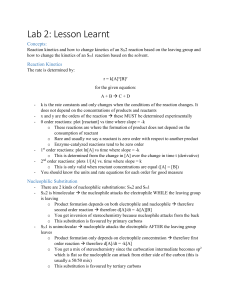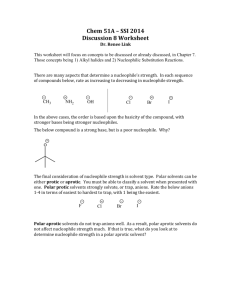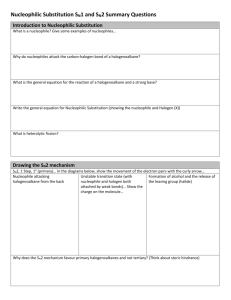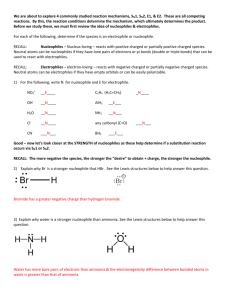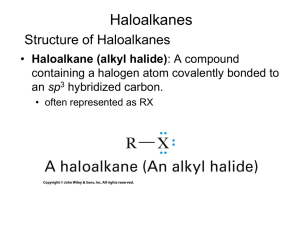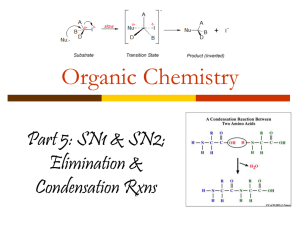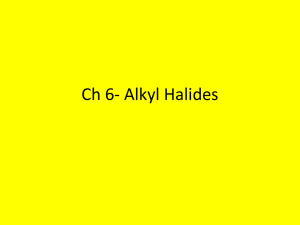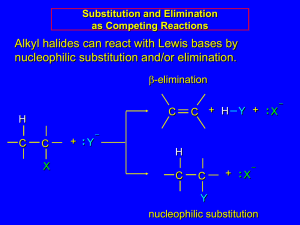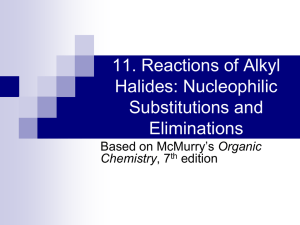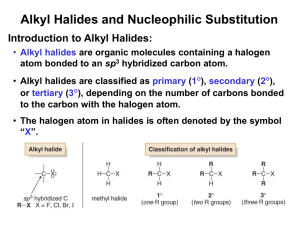Organic halogen compounds
advertisement
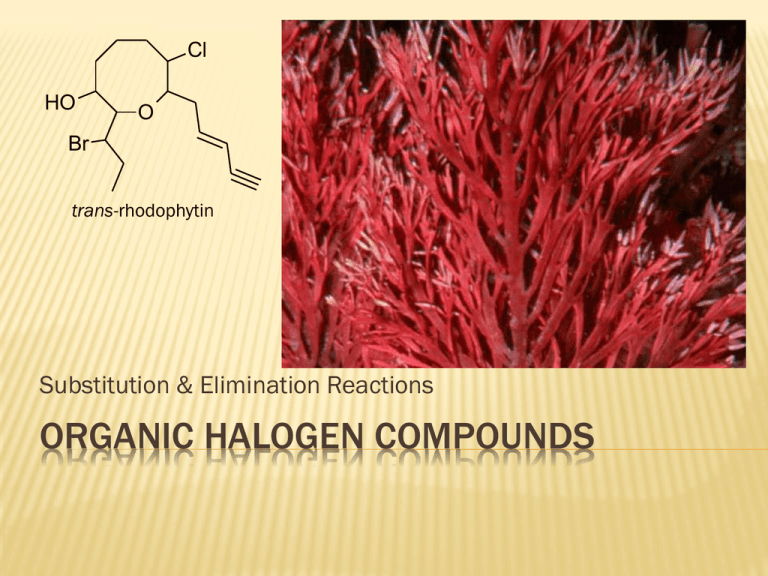
Cl HO O Br trans-rhodophytin Substitution & Elimination Reactions ORGANIC HALOGEN COMPOUNDS HALOCARBONS Cl and Br found in sponges, mollusks Other than that, really just labs Versatile reagents in synthesis rxns Active in substitution rxns Converted to unsaturated compounds through dehydrohalogenation Two or more halogens, practical like fire retardants, refrigerants, Teflon NUCLEOPHILIC SUBSTITUTION A nucleophile displaces halide leaving group from alkyl halide substrate Leaving group takes with it both electrons from carbon-halide bond Nucleophile supplies both electrons for new carbon bond HO HO1- + CH3CH2Br CH3CH2OH + Br1 2 NUCLEOPHILIC SUBSTITUTION Generalized reactions NUCLEOPHILIC SUBSTITUTION Nucleophile Classification Oxygen (OH1-, RO1-, HOH, ROH) Nitrogen (NH3, RNH2, R2NH) Sulfur (HS, RS1-) Halogen (I1-) Carbon (CN1-) NUCLEOPHILIC SUBSTITUTION RO1 Write rxn for sodium ethoxide and bromoethane CH3CH2O Na+ + CH3CH2Br CH3CH2OCH2CH3 + NaBr NUCLEOPHILIC SUBSTITUTION NH3 Complete the reaction NH3 + CH3CH2CH2Br CH3CH2CH2NH3 + Br NUCLEOPHILIC SUBSTITUTION HS Complete the reaction NaHS + CH3CH2CH2Br CH3CH2CH2SH + NaBr NUCLEOPHILIC SUBSTITUTION CN1 Write rxn for the synthesis of propyl cyanide using a nucleophilic substitution reaction K C=N + CH3CH2CH2Cl CH3CH2CH2C=N + K Br NUCLEOPHILIC SUBSTITUTION MECHANISMS Multiple mechanisms Depends on structures of nucleophile, alkyl halide, solvent, temperature Two main types SN 2 SN 1 SN2 MECHANISM One step process Bond to leaving group begins to break as bond to nucleophile begins to form—2 reactants SN2 MECHANISM OH- + bromoethane is example of SN2 Energy diagram SN2 MECHANISM How to determine when it occurs Rate of rxn depends on both nucleophile and substrate concentrations Every SN2 displacement occurs with inversion of configuration The rxn is fastest when the alkyl group of the substrate is methyl or primary and slowest when it is tertiary. Secondary are intermediate. SN2 MECHANISM Illustrate the transition state and the product when cyanide ion reacts with cis-4methylcyclohexyl bromide. SN2 MECHANISM SUMMARY One-step process Favors methyl and primary halides Occurs more slowly with secondary halides Usually not at all with tertiary halides Occurs with inversion of configuration Rate depends on concentration of both nucleophile and substrate SN1 MECHANISM Two-step process First step is bond btw carbon and leaving group breaking as substrate dissociates…slow—1 reactant Carbocation is formed Second step is fast and carbocation combines with nucleophile to give product If nucleophile is neutral, like H2O or ROH, loss of proton from nucleophile O gives final product in 3rd step SN1 MECHANISM SN1 MECHANISM What are the products expected from the SN1 rxn of (CH3)3CCl with CH3OH? Draw an energy diagram. SN1 MECHANISM How to determine when it occurs Rate of rxn does not depend on concentration of nucleophile If C bearing LG is stereogenic, the rxn occurs mainly with loss of optical activity…racemization Rxn is fastest when alkyl group of substrate is tertiary and slowest when it is primary SN2 AND SN1 COMPARED Why do we care? Care about rate of rxn to obtain product in reasonable amt of time Want to know about inversion or racemization beforehand SN2 AND SN1 COMPARED Primary halides, almost always SN2 Tertiary halides, almost always SN1 Secondary are the questionable ones Dependence on solvent polarity and nucleophile solvation Water and alcohol, polar protic solvents, SN1 first step makes ions, so rate is enhanced, and retarded in SN2 Aprotic solvents (i.e. acetone), accelerate SN2 rxns because they leave the anion more naked SN2 AND SN1 COMPARED Nucleophile strength Negative HO1-> ions are more nucleophilic than neutral HOH RS1->RSH RO1->ROH Elements low on periodic table tend to be more nucleophilic than those above in the same group HS1->HO1- I1->Br1- >Cl1->F1- Elements in the same period tend to be less nucleophilic, the more EN it is R3C1->R2N1->RO1->F1- H3N>HOH>HF SN2 AND SN1 COMPARED Variables SN 2 SN 1 Common Sometimes Rarely Rarely Sometimes Common Stereochemistry Inversion Racemization Solvent Rate is retarded by polar protic solvents and increased by polar aprotic solvents Because intermediates are ions, the rate is increased by polar protic solvents Nucleophile Rate depends on nucleophile concentration; mechanism favored when nucleophile is an anion Rate is independent of nucleophile concentration; mechanism is more likely with neutral nucleophiles Halide Structure Primary Secondary Tertiary ELIMINATION REACTIONS Dehydrohalogenation H and X from adjacent C’s are eliminated and a C=C bond is formed ELIMINATION REACTOINS E2 One-step process Nucleophile removes proton on C adjacent to C with leaving group at same time as leaving group leaves and double bond forms ELIMINATION REACTIONS E1 Two-step process with slow first step (like SN1) that ionizes substrate and forms carbocation ELIMINATION REACTIONS E1 Two rxns are then possible for carbocation May combine with nucleophile (SN1) May lose proton from C adjacent to C+ to give an alkene SUBSTITUTION AND ELIMINATION IN COMPETITION Tertiary Halides SN 1 or E1 Weak nucleophile and polar solvent E2 Strong nucleophile (OH1-, CN1-) and less polar solvent SUBSTITUTION AND ELIMINATION IN COMPETITION Primary Halides Only SN2 or E2 Most give substitution products With strongly basic nucleophile E2 is favored SUBSTITUTION AND ELIMINATION IN COMPETITION Secondary Halides All four are possible Stronger nucleophiles that are not bases favor substitution (SN2) Weaker nucleophiles in polar solvents favor substitution (SN1) Strong bases favor elimination (E2) SUBSTITUTION AND ELIMINATION IN COMPETITION Secondary Halides POLYHALOGENATED ALIPHATIC COMPOUNDS Useful properties Effective solvents for organic cpds Some suspected carcinogens POLYHALOGENATED ALIPHATIC COMPOUNDS Carbon tetrachloride—hepatotoxin…used to be used Chloroform—used to make refrigerants and tetrafluoroethylene…once anesthetic Methylene chloride—solvent, paint stripper, degreaser Trichloroethylene—degreaser…once anesthetic Tetrachloroethylene—(PERC) dry cleaning, degreaser POLYHALOGENATED ALIPHATIC COMPOUNDS Chlorofluorocarbons CFC’s (Freons) Made by fluorinating CCl4 Stable Banned use in most countries Tetrafluoroethylene Raw material for Teflon—polymer Non-stick coating because it’s so nonreactive Gore-Tex fabrics (9 billion pores/in2) due to breathability POLYHALOGENATED ALIPHATIC COMPOUNDS Halons Bromine-containing chloro-fluoro carbons Great fire extinguisher Halomon Produced by red algae Anti-tumor properties Br Cl Cl Br Cl

